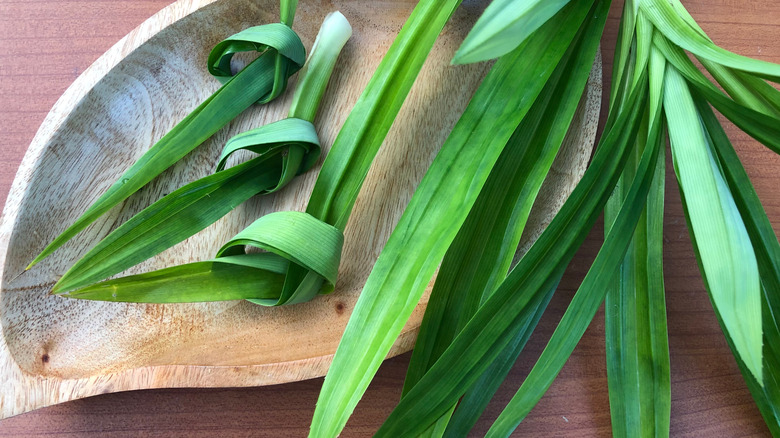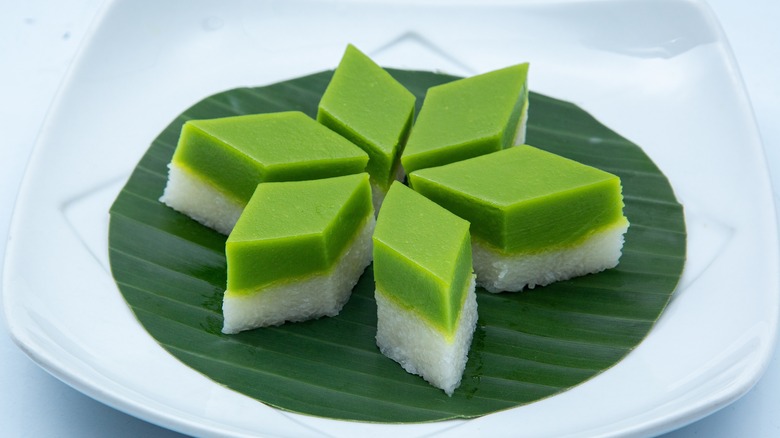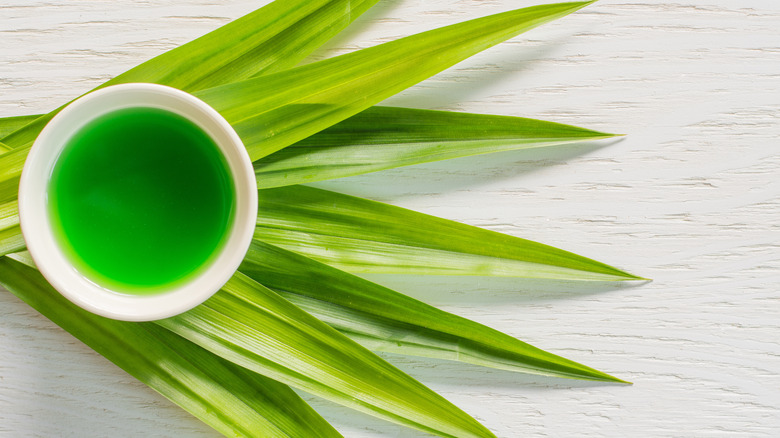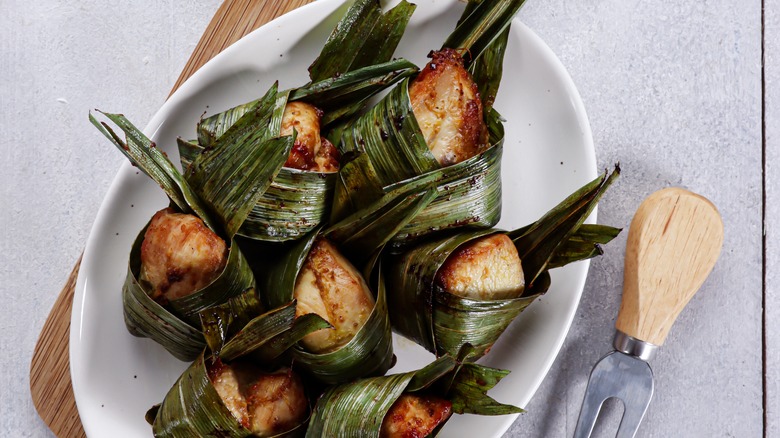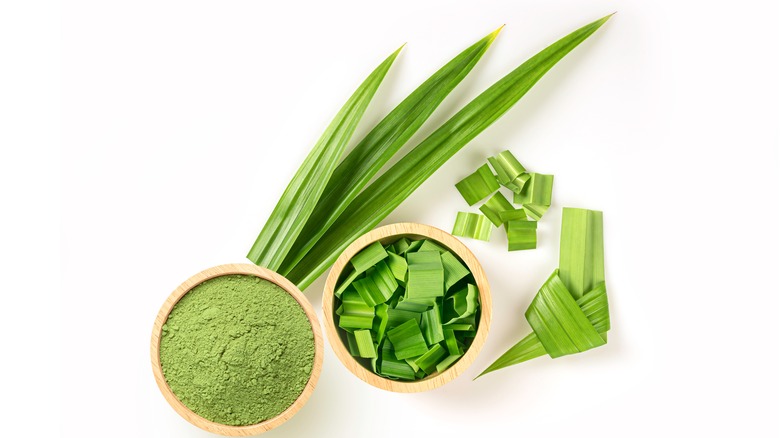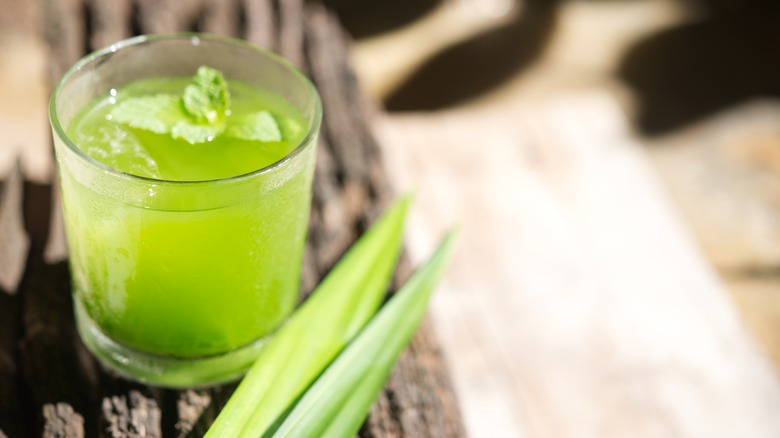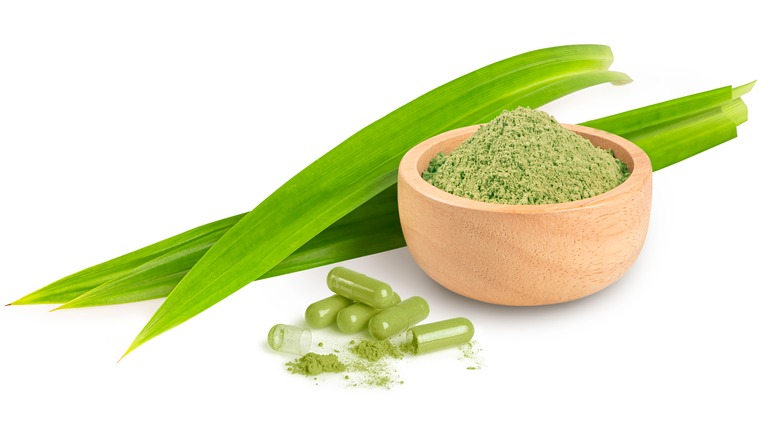What Is Pandan And How Do You Use It?
It might be referred to as the "vanilla of the East," but the Pandanus amaryllifolius is so much more than that. The different cuisines of Southeast Asia are highly dependent on the leaves and extracts from this plant, which are used as a flavoring, food coloring, food wrapping, and even as a tisane.
Pandan's popularity in Southeast Asian cooking can be explained, to some extent, by the fact that it was first found in the Moluccas, which was part of Indonesia, and historically considered to be ground zero for the spice trade. It was believed to have been carried by human travelers out of the area before it was grown in places that were greatly influenced by Malay culture, like Indonesia itself, as well as the Malay peninsula, the Philippines, and certain sections of New Guinea. The aroma of fresh pandan is so fresh and enticing that it is even used as a car freshener.
Pandan is now mostly cultivated in home and commercial gardens, and if you live in a warm climate, it can be very easy to grow. The trick is to find the right plant since there are over 700 different types — and not all of them are edible.
What does pandan taste like?
Pandan leaves an unmistakable impression on people who see and taste it for the first time, particularly when it is used in desserts. Because it goes particularly well with coconut milk and coconut palm sugar, you often see pandan used to make a vibrant, steamed Malaysian layer cake or kuih made with sticky rice and custard.
It is in this popular dessert where the flavors of pandan are most reminiscent of vanilla, with coconut undertones. An earthier tone of that same sweet, vanilla flavor is present in pandan chiffon cake which also carries a green hue.
Pandan tantalizes the tastebuds less and the sense of smell more, when it is used in savory dishes like the famed fried chicken pandan. In this instance, the pandan performs two different tasks: it keeps the meat from drying out and gives the dish a sweet, pleasant aroma overall. But pandan leaves are not meant to be eaten when they are cooked this way, because they have no flavor and add nothing to the dish.
Pandan is available in different forms
Pandan leaves are normally sold either fresh or frozen. Some Asian stores might also sell pandan as fresh juice, in which case the liquid can be stored in the fridge for no more than three days. In the absence of any fresh or frozen leaves, you might be able to track down pandan powder, which is made with freeze-dried leaves.
If no leaves or juice can be found, you might be able to find pandan-flavored extract as well as pandan-flavored paste that will not only impart the flavor of pandan to your cooking but mimic pandan's color too. That said, artificial extracts and pastes can make the dish or dessert you are preparing looking greener than it would be if you were to use the plant's natural extracts. Most professional chefs are not keen on recommending the use of artificial pandan at all.
How to cook with pandan
Some leaves can be consumed raw and as is, while others are boiled or blanched before they are used for cooking. Prepping fresh or frozen pandan leaves so they are ready for cooking savory dishes involves roughing them up so they release their essential oils.
From here, it helps to remember that leaves are generally used to make savory dishes, while extracts, juices, and powders are used to prepare desserts. The long pandan leaves are torn up and then knotted before they are used to flavor and perfume curries and nasi lemak. The leaves can also be crushed and used in fried, grilled, or steamed dishes like the classic chicken pandan.
If you need to juice your leaves, you'll want to pick out darker green leaves, cut those into pieces that are about an inch long, then pound them to soften, before throwing them into a blender with no more than half a cup to a cup of room-temperature water, and straining the mash with a cheesecloth. This can be done two or three times, but the liquid gets weaker each time.
Once the liquid has been extracted, you'll need to leave it to settle overnight to get a more concentrated extract. You'll then be left with pandan water on top, and concentrated pandan extract at the bottom. The lighter water can be used to flavor another dish, while the extract is what you'll use to bake with.
Where pandan can be obtained or purchased
People lucky enough to live in warmer temperature zones — like those who live in Southeast Asia — can grow their own pandan plants, which love sunlight and plenty of bright light. The plants can grow to as high as 50 feet, with leaves that can span up to 10 feet.
Because they don't like cold temperatures and cannot handle frost damage, they are best grown in places where temperatures range between 68 to 86 degrees Fahrenheit — which means in areas south of San Antonio in Texas, places from Arizona to California, and between South Carolina and Miami, Florida. Pandan can also be grown in Hawaii.
But if you live outside of these areas, you're most likely to find fresh and frozen pandan leaves, as well as pandan powder, paste, and extract. These are sold online and at brick-and-mortar locations of many Asian food markets around the country.
Does pandan have any health benefits?
When pandan is used as a flavoring in foods — such as candy, desserts, and other processed foods — it doesn't provide any nutritional benefits as those dishes are generally full of sugar. Pandan paste, on the other hand, is rich in iron. And raw pandan fruit is heavy on fiber.
But this versatile ingredient has other applications in Southeast Asia. There, pandan leaves are valued for their healing properties and when boiled, it is claimed that herbal pandan tea helps treat headaches, body pains, as well as stomach aches. Unfortunately, much of this is anecdotal, as pandan studies are lacking.
That said, a 2021 study revealed promising signs for the use of pandan in anti-dandruff shampoo. Research showed that a combination of extracts obtained from pandan leaves and Noni — a fruit native to Southeast Asia — "inhibited the growth of bacteria isolated from dandruff."
How to store pandan
If you're lucky enough to find fresh pandan leaves at your local Asian supermarket or online, make sure you pick ones that are bright green and don't have any flaws. They need to look vibrant and neither dry nor dehydrated.
After you've brought your fresh leaves home, wash and dry them properly before storing them in the fridge. Make sure to wrap them with a damp cloth or paper towels, which helps them to stay fresh for at least four days, and up to about two weeks (but check them!). They will also keep for three days without refrigeration as long as you don't put them in direct sunlight.
Pandan leaves may also be purchased frozen and can be kept in the freezer for about four months, and possibly up to six months. But they do degrade and will lose their fragrance, which is vital in savory cooking. Fresh pandan extract can be stored in the fridge for up to a week. If your pandan comes in dried or powdered form, the ingredient can be kept in a cool, dry place and per the manufacturer's instructions.
